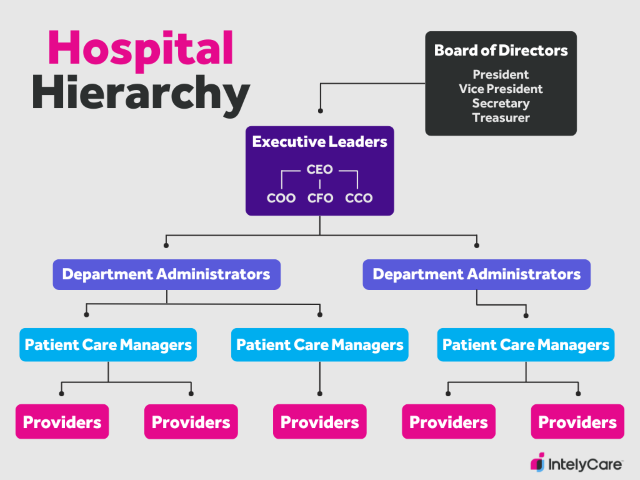Who Is in Charge of a Hospital? Hierarchies and Hiring Strategies

Given the complexities of operating a healthcare facility, you may be wondering who is in charge of a hospital. The reality is, there’s no simple answer to this question. Rather than a sole leader who oversees every business operation, a hospital’s organizational structure is divided into various levels of management. This means that who is in charge of nurses at a hospital differs from who is in charge of doctors at a hospital.
But beyond those who deliver patient care, there are many other managers and staff working to ensure that business is running smoothly. We’ll provide an overview of the hospital hierarchy and provide hiring tips for leaders looking to fill these positions at their own facilities.
The Hospital Chain of Command: Roles and Hiring Strategies
Having a good understanding of how different elements of a hospital team fit together is a great advantage when it comes to developing your hiring strategies. Below is an example of a typical hospital hierarchy, followed by more insights for specific positions.
1. Board of Directors
The board of directors serves as the governing body that guides the overarching goals and policies of a hospital. The board is typically made up of the following hospital executive positions: president, vice president, secretary, and treasurer.
What They Do
- President: Oversees board members and executives, guides hospital priorities and objectives, and serves as the spokesperson of the board to the rest of the workforce
- Vice president: Fills in for the president when needed, develops and guides the hospital’s mission, and sets job descriptions and responsibilities for executives
- Secretary: Recruits and orients new board members, Maintains official records, and distributes agendas for board meetings
- Treasurer: Serves as a liaison between the board and CFO, manages hospital cash flow, delivers financial reports, and monitors debt
Hiring Tips
- Source from previous leaders in business/government, lawyers, doctors, or nurses.
- Strong candidates typically have expertise in leading organizations as well as good communication, leadership, and decision-making skills.
- Have a proactive hiring strategy to fill positions as members reach term limits.
- Utilize your facility’s healthcare talent pool to vet and recruit strong board members.
2. Executive Leaders
Who is in charge of a hospital’s C-suite? Hospital executivesguide the operational direction and strategy of a hospital. Core C-suite positions typically include the Chief Executive Officer (CEO), Chief Operating Officer (COO), Chief Financial Officer (CFO), and Chief Clinical Officer (CCO). However, there are additional C-suite roles that board members can create as needed.
What They Do
- CEO: Oversees the entire C-suite and has final say in business decisions regarding a hospital’s operations, strategy, policies, and finances
- COO: Second-in-command in the C-suite and helps execute decisions made by the hospital CEO
- CFO: Leads the financing and accounting departments across a hospital system
- CCO: Oversees all clinical programs and provides guidance to core clinical staff
Hiring Tips
- Strong candidates typically have previous healthcare-related experience and good leadership, analytical, and managerial skills.
- Thoroughly interview candidates to assess for compatibility in mission and values.
- Train and equip leaders internally to prepare for anticipated leadership transitions.
- Consider whether your facility would benefit from hiring externally to freshen up the overall strategic vision.
3. Department Administrators
With a better understanding of who runs a hospital at the executive level, you may want to know, more specifically, who is in charge of a hospitalward? There are various department administrators responsible for overseeing each division, sector, unit, or ward at a hospital. For example, one administrator may oversee the surgical ward while another administrator oversees the emergency department.
What They Do
Department administrators actively work to create better patient experiences in their designated departments. While healthcare providers manage patients directly, administrators oversee the “behind-the-scenes” operations to facilitate their workflow. This includes managing things like scheduling, hiring, training, unit finances, and regulatory compliance.
Hiring Tips
- Administrators should have in-depth knowledge of healthcare regulations and protocols.
- This role is commonly filled by candidates with a master’s in healthcare administration/management or prior experience working with patients.
- Strong candidates are typically highly organized, personable, and communicative.
4. Patient Care Managers
Patient care managers directly lead the clinical staff in delivering hands-on patient care. For instance, nurse managers or charge nurses oversee all of the nursing staff on a unit, while supervising attendings or physicians oversee residents and other doctors.
What They Do
These managers ensure that patient care orders are being safely and appropriately carried out. Additionally, they guide staff in complying with all legal requirements and unit-level care protocols. When something goes wrong with a patient, they’re the point person responsible for helping resolve any issues. They also supplement administrative duties by overseeing scheduling, patient assignments, and basic HR-related activities for their staff.
Hiring Tips
- Promote and foster leadership internally to strengthen team dynamics and ensure that managers are familiar with their staff/units.
- Managers usually gain years of hands-on clinical experience before being promoted.
- Strong candidates typically have good interpersonal skills and are highly adept at guiding clinical decision-making.
5. Care and Service Providers
Beyond asking, who is in charge of a hospital? It’s important to recognize the frontline staff that sustain essential operations. A hospital can’t function without its care and service providers, ranging from nurses and doctors to transporters and line cooks.
What They Do
Each patient-facing and service-providing role in a hospital holds its own set of distinct duties. Fundamentally, though, these roles need to be performed well to ensure that all patient needs are being met and care is being delivered safely and efficiently.
Hiring Tips
- Create detailed job descriptions to attract the right candidates for each role.
- When conducting interviews, consider how each candidate presents skills that match the specific responsibilities for a given role.
- Diversify your recruitment methods through use of marketing, community/university partnerships, and social media.
Find Talented Staff to Fill Your Positions
Knowing who is in charge of a hospital, and how all of these roles complement one another, is key to understanding, and solving, your facility’s staffing needs. See how you can get the scalable, cost-effective staffing solutions you need to deliver high-quality patient care with optimal efficiency.


